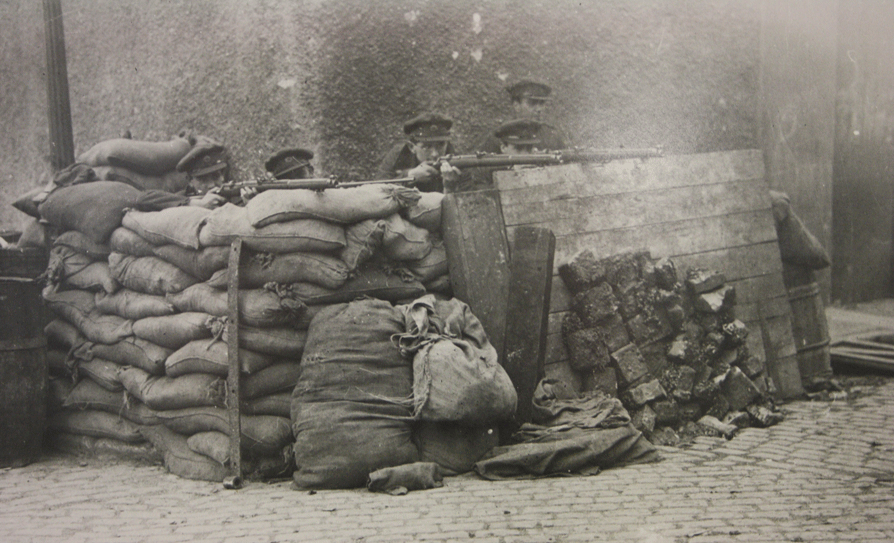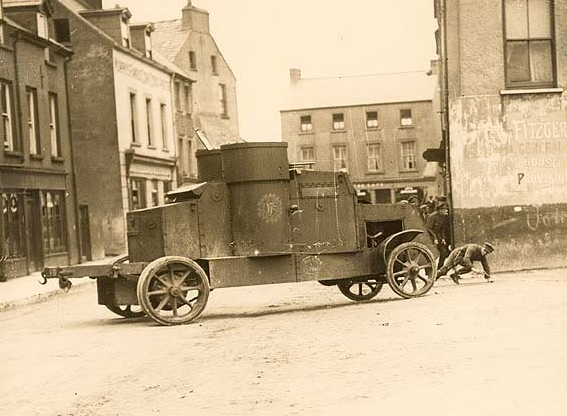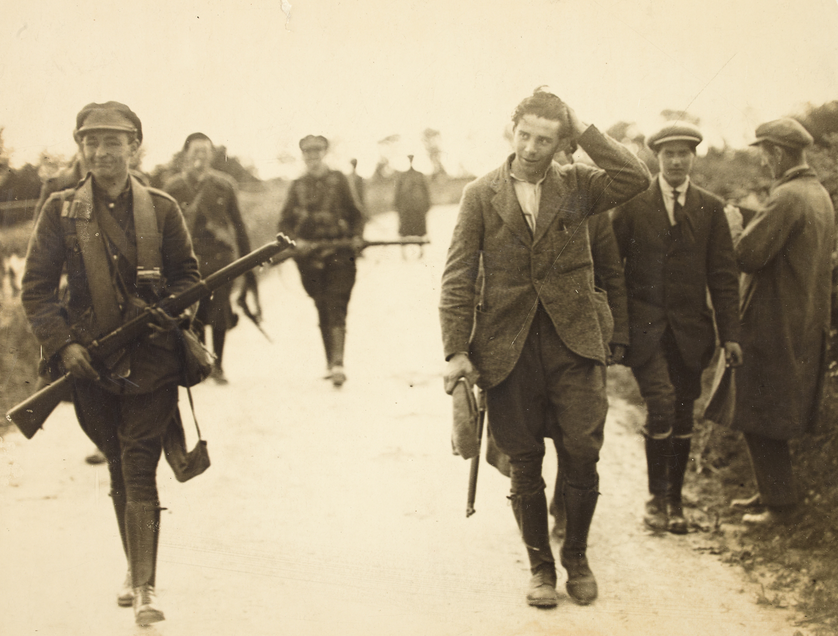On Wednesday 28th of June 1922, the most recognisable building in Ireland, the Four Courts on Inns Quay in Dublin, was enveloped in a cloud of dust as artillery shells imploded into its edifice. The Irish Civil War had commenced.
Background
As the Irish War of Independence came to a close with the signing of a ceasefire in July 1921, Republican forces were divided in relation to the contents of the Anglo Irish Treaty. Over six months later on the 7th January 1922, Dáil Éireann passed the Irish Treaty by 64 votes to 57. This action not only divided the Dáil but also divided the country. Throughout the country armed groups of Pro and Anti-Treaty Forces occupied strategic positions. On the 14th April 1922, Anti-Treaty forces under the command of Rory O’Connor occupied the Four Courts and several other buildings in Dublin city. A tense stand off between Pro and Anti-Treaty Forces commenced.
Anti-Treaty Forces hoped that their occupation of the courts would ignite a confrontation with British troops and thus unite the pro and anti Treaty forces. However, this hope never materialised. Michael Collins and Arthur Griffith came under increasing pressure from London to assert the new governments authority in Dublin and remove those occupying the courts. On the 22nd June 1922, two men assassinated soldier and Unionist politician Sir Henry Wilson in London. Though it was stated that the men were acting on their own initiative, it was suspected that they were acting on orders from Anti-Treaty forces. This action produced an ultimatum from the British government, that they would attack Anti–Treaty forces in the Four Courts unless the Free State government took action. Collins issued a final ultimatum to those occupying the courts. The three-armed parties involved had now reached a point of no return. Civil War was now inevitable.
The Four Courts
Within the Four Courts, Rory O’Connor deployed his men in a defensive role. The complex had been well fortified with Lewis machine guns and rifles covering the main approaches to the building. A commandeered armoured car had been placed at the gates, its Vickers machine gun covering any threat that might materialise. This vehicle could be moved rapidly from point to point depending on the direction of the attack. Windows and doors had been barricaded and a number of improvised explosive devices had been placed at possible entry points. Outside the walls, the newly established Free State Army had recruited many ex- British army soldiers to bolster its ranks. Many of these soldiers were Irishmen who, having served in British regiments during the First World War had gained extensive expertise in tactics and the handling of weapons giving the State army a distinct technical advantage.
Michael Collins, now Commander-in-Chief of the National Army devised a plan of attack. A frontal assault against a fortified building would be costly and those within the courts would have to be removed as a matter of urgency. With a number of eighteen – pounder field guns borrowed from the British army, Collins placed General Emmet Dalton and Colonel Tony Lawlor in command of the assault. The plan was to bombard the occupants into submission. On the 28th June 1922 at 04.10 hours, the bombardment commenced. Shelling was to continue for a number of days. By Friday the 30th June, a fire was raging out of control in the headquarters block that also housed the records office. A huge explosion rocked the city as the records office disintegrated into a cloud of dust. Whether a shell or a mine caused the explosion is not known. Smoke and debris littered the courts as the beleaguered garrison clung on, many of them hoping in vain for a relief column while some planned a breakout.
Shelling and machine gun fire increased and the position became untenable. The Anti-Treaty headquarters staff that included Rory O’ Connor and Liam Mellows decided to surrender. At 16.00 hrs on 30th June 1922, having held out for three days, the Four Courts garrison consisting of 140 men, unconditionally surrendered to Free State Forces. Casualties consisted of three Anti – Treaty forces killed and eight wounded. Free State Forces had lost seven killed and seventy wounded. However, the battle for Dublin was far from over.
The Block
As the battle raged at the Four Courts, other Anti-Treaty units took up position in and around Sackville St. (now O’Connell St.). Commandant Cathal Brugha with an estimated seventy men and women took command of what was to become known as the ‘Block’. This section of the city consisted of fourteen buildings on the east side of Sackville Street that stretched from the corner of Cathedral St. up to Findlater Place. Consisting of four hotels and a number of smaller buildings, the ‘Block’ had been turned into a fortress by means of mouse holing (a technique that involved burrowing through internal walls, therefore, connecting each position and not exposing ones men to enemy fire). Anti-Treaty commanders such as Eamon De Valera, Séan T O’ Kelly and Austin Stack joined Brugha in the defence of the buildings.
As the battle for the Four Courts drew to a close, Free State Forces turned their attention to the centre of the city. Commandant Tom Ennis was the officer of the Free State army given the task of removing the Anti-Treaty forces from the ‘Block’. On Monday 3rd July at 02.00 hrs he moved his troops into position. Firefights erupted between the rival factions as Free State forces attempted to gain a foothold in the capital. Free State armoured cars and personnel carriers careered onto the city’s streets disgorging their cargo of troops. Machine gun fire from the turrets of the armoured cars ripped along the frontage of the ‘Block’. A cordon was established around the centre of the city. By 03.15 hrs Free State forces had completed their enveloping movement.
Artillery was moved into position and the bombardment of the ‘Block’ commenced. Small Anti-Treaty units fought from each post within the ‘Block’ and when their position became untenable they withdrew further into the labyrinth of tunnels that linked each building. At 20.00 hrs on Tuesday 4th July 1922, Free State Forces unleashed their final assault on the ‘Block’. Artillery fire, rifle fire, rifle grenades and machine-gun fire were directed on to the row of buildings.
However, it was 17.00 hrs on Wednesday 5th July, after hours of fighting, that the last Anti –Treaty stronghold, the Hamman Hotel, was in flames. The building burned fiercely as Commandant Brugha realising his position was untenable, ordered his unit to surrender. With his pistol drawn, Brugha calmly walked out the front door towards the waiting Free State troops. He was shot and seriously wounded, the bullet severing his femoral artery. Though he received immediate medical attention, he died two days later on July 7th in the Mater hospital. Cathal Brugha’s death was just one of a long list of prominent figures that would, in the following months lose their lives during the Civil War.
Though the Battle for Dublin had ended, the battle for Ireland had just begun.
Written by Paul O’Brien
First published in An Cosantóir Magazine, The Offical Magazine of the Irish Defence Forces.



